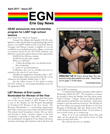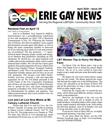The rise (and fall) of an LGBT miniseries
by Mark Segal of Philadelphia Gay News
How many of you watched the ABC miniseries "When We Rise"? Not many, according to the ratings.
That might be due to several factors, among them the way the LGBT history series was promoted and its lukewarm reviews. My take is this:
Overall, the series was more a history of San Francisco's part in LGBT history than of the national movement. That's great, but don't promote it as LGBT history. LGBT history, or rather the movement for LGBT rights in the United States, began in 1925, not 1971, as you'd believe from "When We Rise."
Major events in our history were just one-liners in this miniseries. Dustin Lance Black, who spearheaded this project, is and has been West Coast-oriented, which is fine, but to limit our history in such a major project might have been its downfall. To be fair, the stories were compelling and the series weaved in some national LGBT history, but all from a San Francisco bent. Those same efforts were going on in other cities as well.
In the end, the show is about four individuals and their travels through that time period, 1971 to the present. That's valid, as all personal reflections are, but billing them or the overall tenor of San Francisco as similar to what we in other parts of the country were and are experiencing does not add up.
San Francisco is important to our national struggle but, to paraphrase a friend from the city, San Francisco is a legend in its own mind - but we like it. Maybe not the miniseries.
Mark Segal, PGN publisher, is the nation's most-award-winning commentator in LGBT media. His recently published memoir, "And Then I Danced," is available on Amazon.com, Barnes & Noble or at your favorite bookseller.




